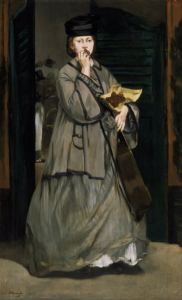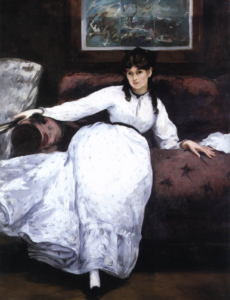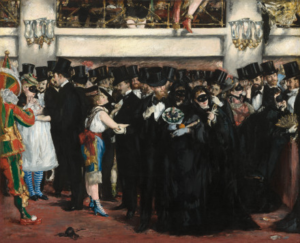MANET AND MODERN LIFE
Édouard Manet was not the artist that the Second Empire would have selected to be its chronicler, but, in the end, it was Manet’s impressions of France’s last monarchy that would make an indelible mark on the public memory. Napoléon III followed in his uncle’s footsteps when it came to art. Although he knew less about art than the former Emperor, he was determined to harness the visual arts to the machinery of the Empire. The designated watchdog for the difficult and hard to handle artists was Comte de Nieuwerkerke who remorselessly restricted entry to the Salon both in number of works allowed and in kind of subject matter approved. The Count wanted to stop time and to force the artists to concentrate on the ancient past and, if the artist wanted to do contemporary topics, these offerings should add to the glory of France. It could be argued that Manet was very conscientious in recording the glory days of the Second Empire, but he recorded too much, too well. “The eye,” Manet said, “should forget all else it has seen…and the hand become…guided only by the will, oblivious of all previous training…” It would take a flâneur with an adventurous spirit to capture the empty splendor and gaudy spectacle that was the Second Empire.
The laughing, blond Manet
Emanating grace
Gay, subtle and charming
With the beard of an Apollo
Had from head to top
The appearance of a gentleman.
Théodore de Banville, poet
Manet was trained by the open-minded academic painter, Thomas Courture for six years but drifted away from ancient precedents. The successor to Gustave Courbet as the resident rebel, Manet was part of the dominant class and not particularly interested in the lower classes per se, as a political topic. For Manet the main opponent was the Salon system itself and he jousted with the received language and rules of art and the unrelenting hostility of the jurors of the Second Empire. His early foray into the art of modern life, Music in the Tuileries (1862) was rejected by the jury for its sketchy treatment of a non-narrative version of modern life. Fashionable Parisians met and mingled in the fashionable garden: the men in their black frock coats and tall shining top hats, the women in their full skirts, perched precariously on the new wire backed chairs, and a little girl playing in her brightly sashed dress. There were over a dozen portraits of notable Parisians, Baudelaire and Champfleury, members of the artistic elite—music, literature, art, poetry—brought together in a crowd that included the artist. The painting could be seen as a counterpart of Courbet’s Funeral at Ornans, painted over a decade before. Modern life was being redefined, not as the situation of the country folk but as the pleasures of urban sophisticates.
When seen in relation to his entire oeuvre, Manet’s nudes, Le Dejeunner sur l’herbe and Olympia, were ploys, a means to get noticed. The heavy quotation of historical paintings fit better into a part of body of work that showed his devotion to Spanish and Dutch masters of past times. (For a further discussion of the way in which Manet mined the history of art, see Michael Fried “Manet’s Sources” in his book, Manet’s Modernism, 1996) The scandalous nudes helped make his mark, but the strategy of quoting (perhaps mocking) classical traditions would quickly give way to the detached and disinterested portrait of modernité. Manet’s The Street Singer (1862) serves as a useful comparison to Courbet’s The Young Women of the Village Giving Alms to a Cowgirl, painted around the same time. The critics were sarcastic to Courbet for the pretentions of the three young women—so obviously lower middle class—who dared to give charity. What was perhaps worse for the critics was the unfashionable attire of the women (Courbet’s sisters), who were dressed for the country but did not wear the layers of the crinolines required of city women. Manet’s street singer is a woman of the same social stratum, aspiring lower class, making her way in the world in a precarious profession. She sweeps by in her chic and fashionable dress, exuding the urban self-assurance and street smarts of a city woman.

Édouard Manet. Street Singer (1862)
Trapped in an unhappy and unfulfilling marriage of inconvenience, Manet was a great appreciator of women. When men appear in his art, they are usually supporting figures, or they are solitary portraits, such as of his critics, Emile Zola and Théodore Duret. However, Manet did, when the occasion arouse, forayed into contemporary history painting and the deeds of modern men. Among his best-known history paintings is Execution of Maximilian of 1867, a clear rebuke to the Emperor and his imperialist ambitions. Over-eager to follow in his uncle’s footsteps, Napoléon III, had attempted to manipulate Mexican politics while the Americans were looking the other way, fighting a protracted Civil War. The result was a disaster for the tragic puppet rulers, Maximilian and Carlotta, who set up a short-lived European court in Mexico City only to be quickly deposed. Maximilian and his closest advisors were executed, ending the ill-advised adventure. Working from newspaper accounts and photographs of the August event, Manet based the painting of the execution on Goya’s The Third of May of 1808 (1814), but eradicated the earlier artist’s symbolism. There are five versions of this difficult composition, the best known in Mannheim today. According to Michael Fried, this is one of the many works by Manet that were “…within the framework of a contemporary discourse of painting with its own history…” But the art historian quite correctly points to the dialectic within Manet’s works, that of the “universality” of references clashing with “…contemporary painting’s deeply problematic relation to the great art of the past.”
It is the female who is Manet’s signifier of Modern Life, because she, the powerless outcast, carried the unquestioned political and social power of the bourgeois male. The artist was the consummate flâneur, the sophisticated dandy, who strolled elegantly among the crowd. Independently wealthy, he was able to partake of the many sexual pleasures the city of Paris could offer the haute bourgeois male. Inflicted with syphilis, as were most males of the time, Manet frequented the brothels and cabarets and bals, all of which featured available women for hire. The presence of these anonymous women of the city, fighting to survive in their unsavory trade, stand in comparison to perhaps the love of his life, the artist, Berthe Morisot, who would later marry his brother, Eugène. Unlike the professional women who were forced into the sex trade, Morisot came from the same background of privilege as Manet. A professional artist herself, she would often pose for him, so many times, in fact, that it becomes clear that the posing sessions were occasions for the couple to enjoy each other’s company. She is seen “lounging,” in a manner that disconcerted the critics, in Repose, or sitting stiffly in The Balcony (1868–9), her dark and brooding beauty commanding the canvas. Her gravity and seriousness outweighs the lightweight charmer, Nana, the enchantress of the brothel boudoir.

Édouard Manet. Manet. The Repose (1870)
The friendship of Manet and Morisot was indicative of other partnerships that would be forged, for example, Edgar Degas and Mary Cassatt. Such friendships between men and women of equal rank were rare during the Nineteenth Century. In the late Nineteenth century, it was thought that croquet, a newly invented game, could take the place of actual warfare, but this new form of combat was a threat to the good order of society because men and women played together. A “mixing of the sexes” was reserved for the unequal relationships between the upper class male and the lower class female. This mixing can be seen in Manet’s Ball at the Opèra, painted three years after the end of the Second Empire in 1873. The Third Republic proved to be no more moral than that of the Empire and the “decadence” that had supposedly brought down Napoléon continued unabated. Once again, Manet employed the now familiar device of the crowd stretched out in an isocephalic arrangement. The gentlemen in their black uniforms mingle with the women for hire. Both groups are in disguise: the men in their anonymous clothes are unseen and disappear into the crowd; and the women in their masks and costumes are on display for male selection. This scene has been called a “meat market,” by art historians, meaning that the men were indulging in the favorite pastime of the Parisians, shopping.

Édouard Manet. Masked Ball at the Opèra (1873)
Perhaps the greatest and most successful painting of Modern Life was the Bar at the Folies-Bergère. Painted in 1882, few years before his untimely death, this large work, located at the Courtauld today, could be seen as Manet’s final overcoming of art history, which he overwrote with the present. The setting is a café concert, a new kind of entertainment for the masses, emerging during the Second Empire as part of the spectacle offered to the lower classes. So alluring was this dazzling combination of performance and social mixing that the upper class male could be found in the crowd of lower middle class workers, identified by T. J. Clark, in The Painting of Modern Life (1985) as the caicots, the lower order professionals, such as bank clerks. The only women in such a place are those who are for sale, sexually available. At the center of the painting is a bored bar maid, who is wedged between the bar and the mirror behind her. The mirror, which stretches beyond the edge of the canvas, can be understood as reflecting the unseen foreground—the concert—because of the reflections of the woman, the femme de comptoir, and her customer, a gentleman in a top hat, which can be seen in the mirror. The reflections are misplaced and function as orientating clues about the mirror, for in “real life,” neither reflection would be possible from the vantage point of the viewer of the painting. The mirror can be read as “mirror,” because the painting is “wrong,” rejecting the “correct” manner of showing mirror images. In writing about The Bar, T. J. Clark stated, “There seems little doubt that the structure which gives rise to these uncertainties was devised by the artist with conscious care…” The Bar is one of Manet’s final mysteries, combining foreground (in the mirror), which thus becomes background with the middle ground (the bar maid and the still lives laid out on the bar) and includes the viewer’s foreground, but makes the spectator’s position in doubt. Where do I stand? What is my viewpoint? The audience has been de-centered. The question is what did Manet do and why did he do it? This painting connects with the rest of Manet’s oeuvre in the way he played with space, which, with Manet, was always unreadable. The key word is “play,” for the artist was playful with the elements of traditional art. Manet’s favorite target was the deep space created by Renaissance perspective, beginning with his elimination of the dark ground in favor of his famous “blond” tone, which precluded a feeling of pictorial depth.

Edouard Manet. A Bar at the Folies-Bergère (1882)
However, one should not leap to the conclusion that Manet is “flattening” the surface, as Greenberg insisted. Greenberg was constructing a theory and therefore, not necessarily seeing “into” the work. Many of Manet’s paintings depend upon the viewer. This dependency does not resemble what Michael Fried termed “theatricality,” but is more related to German playwright, Bertold Brecht’s “alienation effect,” in which the audience is made aware of itself, breaking the illusion of realism. Traditional painting placed the spectator outside the “window to the world,” peering through the picture plane. Manet, however, placed the spectator within the scene. The viewer is forced to interact with the events and becomes part of a usually disreputable place, like a brothel or a cabaret. Once the viewer is freed from his or her role as outsider, art, with Manet, became the play of new possibilities. The one theme that recurs in his career is that of the right, if not the duty, of the artist to play and, through play, to challenge. In his last great painting, Manet explained his artistic credo: art, before it is anything else, is not real; art is artificial.
If you have found this material useful, please give credit to
Dr. Jeanne S. M. Willette and Art History Unstuffed. Thank you.